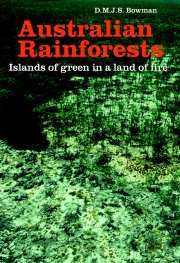Book contents
- Frontmatter
- Contents
- Preface
- 1 Introduction
- 2 What is Australian rainforest?
- 3 The sclerophyll problem
- 4 The edaphic theory I. The control of rainforest by soil phosphorus
- 5 The edaphic theory II. Soil types, drainage, and fertility
- 6 The climate theory I. Water stress
- 7 The climate theory II. Light and temperature
- 8 The fire theory I. Field evidence
- 9 The fire theory II. Fire, nutrient cycling, and topography
- 10 The fire theory III. Fire frequency, succession, and ecological drift
- 11 The fire theory IV. Aboriginal landscape burning
- 12 The fire theory V. Aridity and the evolution of flammable forests
- 13 The fire theory VI. Fire management and rainforest conservation
- 14 Summary
- References
- Index
10 - The fire theory III. Fire frequency, succession, and ecological drift
Published online by Cambridge University Press: 23 November 2009
- Frontmatter
- Contents
- Preface
- 1 Introduction
- 2 What is Australian rainforest?
- 3 The sclerophyll problem
- 4 The edaphic theory I. The control of rainforest by soil phosphorus
- 5 The edaphic theory II. Soil types, drainage, and fertility
- 6 The climate theory I. Water stress
- 7 The climate theory II. Light and temperature
- 8 The fire theory I. Field evidence
- 9 The fire theory II. Fire, nutrient cycling, and topography
- 10 The fire theory III. Fire frequency, succession, and ecological drift
- 11 The fire theory IV. Aboriginal landscape burning
- 12 The fire theory V. Aridity and the evolution of flammable forests
- 13 The fire theory VI. Fire management and rainforest conservation
- 14 Summary
- References
- Index
Summary
In Chapter 8 I summarised a large body of Weld evidence, collected throughout the geographic range of Australian rainforest, that strongly suggested that fire plays a major role in controlling rainforest boundaries. However, I also showed that the relationship between fire and rainforest distribution is not simple. Rainforest trees are best differentiated from non-rainforest tree species by their inability to survive recurrent fires; most rainforest tree species can regenerate after a single fire. Thus, the frequency of fires is critical in controlling rainforest. In the previous chapter, I showed that differences in soil fertility across rainforest boundaries reflect the cumulative effect of fire history. In an influential paper published in 1968, Jackson emphasised the role of fire frequency in determining soil fertility and vegetation types in western Tasmania. Specifically, he developed the ‘ecological drift’ theory that emphasised the importance of variation in fire frequency in determining the distribution of vegetation types, including rainforest, in western Tasmania. Has Jackson found the key to understanding the distribution of Australian rainforest? In this chapter, I critically review Jackson's theory.
Rainforest, succession and the ecological drift model
Jackson (1968) set out to answer a simple question: why should rainforest be spatially restricted in western Tasmania? With its cool, mid-latitude oceanic climate and an annual rainfall in excess of 2000mm distributed throughout the year, western Tasmania would seem ideal for cool temperate rainforest. However, rainforest is of limited extent and treeless sedgelands dominated by Gymnoschoenus sphaerocephalus (commonly known as button-grass) are widespread (Figure 10.1).
- Type
- Chapter
- Information
- Australian RainforestsIslands of Green in a Land of Fire, pp. 196 - 217Publisher: Cambridge University PressPrint publication year: 2000



